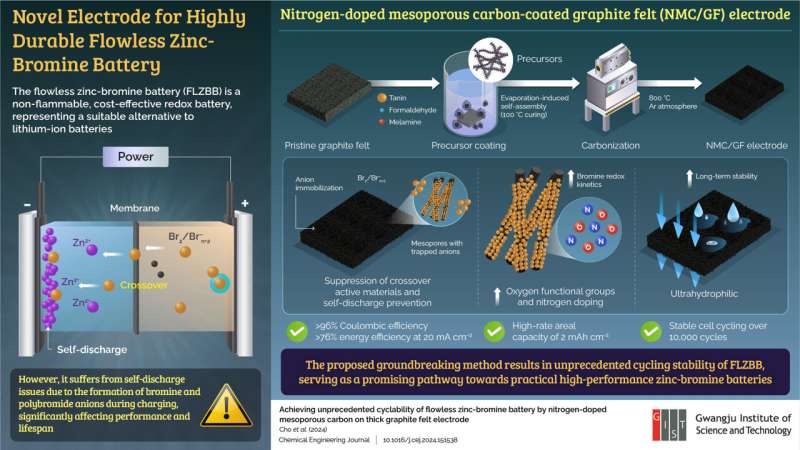
Due to rising environmental concerns, global energy production is shifting from fossil fuels to sustainable and renewable energy systems such as solar and wind power. Despite their advantages, they have two significant weaknesses: volatile power production and irregular supply. Hence, they are augmented with energy storage systems (ESSs).
Lithium-ion batteries are at the forefront of ESSs but are prone to fires due to flammable electrolytes and lithium-based materials. The flowless zinc-bromine battery (FLZBB), which uses non-flammable electrolytes, is a promising alternative, offering cost-effectiveness and a simple battery platform.
An FLZBB consists of a positive electrode, a negative electrode, an electrolyte, and a separator to keep the electrodes apart. Unlike conventional zinc-bromine batteries, the electrolyte in FLZBB does not need to be pumped and is instead held in a gel-like container. Graphite felt (GF) is widely used as an electrode in many redox batteries due to its stability in acidic electrolytes.
However, in FLZBBs, bromine and polybromide ions are formed within the GF-positive electrode during charging. These active materials can escape and diffuse uncontrollably to the negative electrode, causing self-discharge, which severely affects performance and lifespan. Many studies have explored approaches to suppress this crossover phenomenon; however, self-discharge remains a major issue for FLZBBs.
To address this issue, a team of researchers led by Professor Chanho Pak and including integrated M.S. and Ph.D. student Youngin Cho (first author) from the Graduate School of Energy Convergence, Institute of Integrated Technology at Gwangju Institute of Science and Technology, Korea, developed a novel nitrogen-doped mesoporous carbon-coated thick GF (NMC/GF) electrode. Their study was made available in Chemical Engineering Journal on June 15, 2024.
The researchers fabricated the NMC/GF electrodes using a simple, cost-effective evaporation-induced self-assembly method. In this method, a pristine GF felt was coated with precursor materials and mixed in a solvent, followed by drying and curing. When applied to an FLZBB, the new electrodes effectively suppressed the crossover of the active materials and prevented self-discharge. This success was attributed to the mesopores present on the GF fibers in the NMC/GF electrodes.
Prof. Pak explains, "The NMC coating on the GF electrodes introduced mesopores with strategically embedded nitrogen sites, which served as a stronghold, capturing the bromine and bromine complexes in the positive electrode, suppressing bromine crossover and self-discharge phenomena.
"Moreover, this coating made the originally hydrophobic pristine GF electrodes ultrahydrophilic, improving interfacial contact with the electrolyte in the aqueous electrolyte and enhancing electrochemical performance. Additionally, it allowed the incorporation of abundant oxygen and nitrogen species, which improved bromine reaction speeds, further boosting performance."
The FLZBB with NMC/GF electrodes demonstrated excellent Coulombic and energy efficiencies of 96% and 76%, respectively, at a current density of 20 mA cm-2, as well as a high-rate areal capacity of 2 mAh cm-2. Furthermore, the battery exhibited unprecedented durability, with charge/discharge cycling stability extended to over 10,000 cycles. Also, the thick GF electrode used can potentially reduce the overall price of the battery.
Highlighting the significance of this achievement, Prof. Pak says, "The development of FLZBB positive electrode, which maintains long-term operation over 10,000 cycles with high efficiencies, will accelerate the development of stable ESSs and eco-friendly energy conversion in the long term. Moreover, NMC/GF positive electrode can also be used for other aqueous batteries."
This technology can enable practical applications of FLZBB, leading to safer ESSs and more stable renewable energy systems.
More information: Youngin Cho et al, Achieving unprecedented cyclability of flowless zinc-bromine battery by nitrogen-doped mesoporous carbon on thick graphite felt electrode, Chemical Engineering Journal (2024). DOI: 10.1016/j.cej.2024.151538
Citation: Researchers develop novel electrode for improving flowless zinc-bromine battery (2024, July 18) retrieved 18 July 2024 from https://techxplore.com/news/2024-07-electrode-flowless-zinc-bromine-battery.html
This document is subject to copyright. Apart from any fair dealing for the purpose of private study or research, no part may be reproduced without the written permission. The content is provided for information purposes only.
